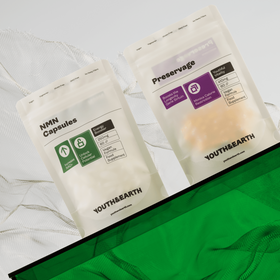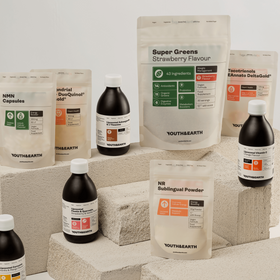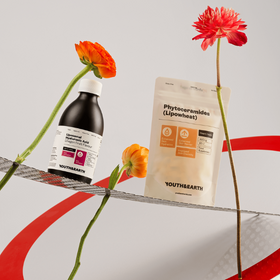Did you know that vitamin D3 or cholecalciferol is not only crucial for bone health but also boosts your immune system and can help improve cardiovascular functioning? Find out why it’s important to make sure that your levels of this anti-aging vitamin are optimal.

As you go about your daily life, have you ever stopped to think wonder if you have any nutritional deficiencies? For example, does it concern you that your daily intake of vitamin D3 could be below the 10–20 micrograms recommended by the US Institute of Medicine?
Given the pivotal role vitamin D plays in the body, insufficient quantities could hamper your level of activity, productivity, and ultimately compromise your health.
What is Vitamin D and Cholecalciferol?
Choleciferol is one of the forms of vitamin D. Vitamins are carbon-containing molecules that are classified as organic and are very important for cell function, growth, and development. So far there are 13 known vitamins – 9 of which are soluble in water and 4 soluble in fats or lipids. Vitamin D together with vitamin A, E, and K are fat-soluble and are absorbed through the digestive tract.
Vitamin D was discovered in the early 20th century as a primary cure for rickets. Initially, there were 3 forms of vitamin D (D1, D2, and D3). However, it was later discovered that vitamin D1 was a product of the irradiation of vitamin D2 and tachysterol and was delisted as a separate form.
The only nutritional forms of vitamin D found in humans are vitamin D2also known as ergocalciferol and vitamin D3 known as cholecalciferol. The source of vitamin D2 is plant sterols while D3 is made by the skin.
How is Cholecalciferol (Vitamin D3) Synthesized?
Vitamin D3 is manufactured from a special lipid (a zoosterol) called 7-dehydrocholesterol (7-DHC) that’s found in the epidermis layer of the skin. This lipid is also involved in the biosynthesis of cholesterol.
When it is exposed to solar radiation, the sterol absorbs photons from the ultraviolet B (UVB) radiation range. This results in a photochemical reaction known as photolysis which forms precholecalciferol or pre-vitamin D3. It then undergoes another process called thermal isomerization which reorganizes it into a more stable inactive vitamin D3 or cholecalciferol molecule.
When newly synthesized, vitamin D3 is inactive and has low solubility in water. Therefore, it moves out of the plasma membrane of skin cells into the extracellular fluid. Here, it attaches itself to the vitamin D3 binding protein (DBP) and is transported through the blood to the liver.
In the liver, the inactive vitamin D3 undergoes a process called hydroxylation to convert it to calcidiolor 25-hydroxyvitamin D (25(OH)D). This molecule is then transported to the kidney where it’s converted from calcidiol to calcitriol or 1,25(OH)D.
While calcitriol is the most active form of vitamin D3, normally calcidiol is used as the indicator of vitamin D3 status in a person. So when you get a blood test, this will be the form of vitamin D that is measured and it’s the most abundant form of vitamin D3 in the circulatory system.
It’s important to note that healthy liver and kidney function plays an important role in converting the inactive cholecalciferol (vitamin D3) into the more active forms of calcidiol and calcitriol. For more on how our bodies make vitamin D, watch this video by Corporis.
What is Vitamin D3 Good For?
Vitamin D3 plays a crucial role in regulating physiological processes such as calcium metabolism (for bone development and health), immunity, cellular growth, and cardiovascular function. Interested in how it does this? Let’s dig in, here are some of the ways it benefits our health.
Vitamin D3 helps calcium and phosphorous absorption - essential minerals for bone health
Optimal absorption of calcium and phosphorus is crucial in the prevention of osteoporosis and the protection of bone. The total amount of calcium the body absorbs from the diet is dependent on two main factors: One is the actual quantity consumed and the other is the efficiency of the absorption process which is regulated by vitamin D3.
In a 2008 research study, researchers showed that vitamin D3 deficiency ultimately causes calcium malabsorption. In the intestine, calcitriol, the active form of vitamin D3, binds to vitamin D receptors (VDR) and stimulates the calcium transport system.
For phosphorus absorption, calcitriol increases the levels of the sodium-dependent phosphate transport system which helps the cells absorb more phosphorus.
Vitamin D3 May Help Protect the Brain and Preserve Neurological Development
A study published in 2012 showered that calcitriol (the active form of vitamin D 3) has some neuroprotective effects. For instance, it was found to be effective in eliminating amyloid plaques, a typical characteristic of Alzheimer’s.
In an in-depth literature review of the role of vitamin D3 and neurological development and brain health, the researchers concluded that there is mounting evidence to suggest that vitamin D is required for normal brain development and function. They found an association between low levels of vitamin D3 and a broad range of neurological conditions such as Alzheimer’s Disease, Parkinson's Diseases, multiple sclerosis, and other neurocognitive disorders. The researchers concluded that more studies are needed in this field seeing as vitamin D supplementation is widely available.
Vitamin D3 May Help Fracture Repair
There are two ways of looking at the relationship between vitamin D3 and fractures. First, when vitamin D3 levels are low, individuals may develop conditions such as osteoporosis and weak muscles that can increase the risk of falls and fractures.
When fractures occur, vitamin D3 comes in to help in the healing process. In a small studyon vitamin D status and adult fracture healing, researchers found that fracture healing was delayed in participants who were vitamin D deficient. They concluded that the research seems to indicate that vitamin D status at the time of fracture affects fracture healing.
Vitamin D3 May Help Cardiovascular Health
Arterial hypertension is one of the main risk factors behind global morbidity. Vitamin D3 and its effect on cardiovascular health, has been an area that has attracted lots of scientific research, although the results have been inconsistent and more studies need to be done. In a literature review, researchers concluded that the current evidence suggests that lower vitamin D levels correlate with a higher risk of cardiovascular disease and related conditions but more conclusive research is needed.
Vitamin D3 May Help Strengthen the Immune System
The vitamin D receptor (VDR) is present in immune cells such as antigen-presenting cells, T cells, and B cells. This means that the cells can synthesize the active form of vitamin D3. Research has shown that vitamin D3 can regulate your immune response hence boosting autoimmunity and minimizing susceptibility to infections.
Vitamin D and COVID
In light of the COVID pandemic, a number of medical societies released a joint statement on vitamin D and COVID: “The current data do not provide any evidence that vitamin D supplementation will help prevent or treat COVID-19 infection; however, our guidance does not preclude further study of the potential effects of vitamin D on COVID-19. Research to date suggests that vitamin D may play a role in enhancing the immune response, and given prior work demonstrating a role for the activated form of vitamin D [1,25(OH)2D] in immune responses, further research into vitamin D supplementation in COVID-19 disease is warranted.”
However, they do recommend, in light of the observational evidence that has been noted, that people get 15-30 minutes of sunlight on their skin daily (without sunburn) or take a vitamin D nutritional supplement to ensure that they have optimal vitamin D levels.
Should You Take Vitamin K with Vitamin D3?
Although more research is needed, there is a growing body of evidence that suggests that it’s important to take vitamin K with vitamin D3 because the joint supplementation may be more effective for bone and cardiovascular health.
Calcium is important in maintaining bone health. However, for it to be absorbed effectively and reach the bone mass, it needs the input of vitamin D3 and vitamin K2. Vitamin K2 (also known as MK-7) is especially important as it activates osteocalcin, a protein that integrates calcium into bone. Vitamin D and vitamin K operate together to ensure that your bones absorb sufficient calcium.
Vitamin K2 is also responsible for activating the matrix GLA protein. The activated protein then binds to excess calcium which enhances arterial flexibility and flow. This prevents arterial calcification, reduces the narrowing of blood vessels, and minimizes the risk of a heart attack.
Vitamin K can be found in the following foods:
-
Green leafy vegetables such as kale, spinach, collards, and green leaf lettuce.
-
Green vegetables such as broccoli, cabbage, cauliflower, and Brussels sprouts.
-
Fortified cereals, fish, liver, meat, and eggs.

Is Vitamin D Anti-Aging?
Yes, because of its essential role in many of the processes in the body such as bone, neurological, and immune health, vitamin D3 is an important anti-aging molecule that you should include in your longevity health regime.
As you age, the production of calcitriol is cut by 50% due to age-related deterioration of the renal function. Declines in renal function lead to reduced activity of the enzyme responsible for converting calcidiol into calcitriol.
Aging also leads to pre-vitamin D3 by about 50% of vitamin D in the skin. Compared to young people, older people have a reduced concentration of 7-dehydrocholesterol, the vitamin D3 substrate in the epidermis. Also, the elderly experience a reduced response to UVB light. This cuts further the formation of pre-vitamin D3 by about 50%.
There are also indications that vitamin D may protect telomere length, an indicator of aging. In a study, it was shown that a nationally represented population of adults, levels of vitamin D were associated with longer telomere length independently of other factors. This is thought to be because of the anti-inflammatory properties of vitamin D.
For more on vitamin D and aging, as well as how to find the “sweet spot,” watch this video below by Dr. Rhonda Patrick.
Looking for more on natural supplements that are anti-inflammatory? Read What is Krill Oil and Why Is It Good For You?
What Causes Low Vitamin D Levels?
Low vitamin D levels can be caused by a number of factors:
-
Dietary inadequacy: The NHS recommends that adults need to get about 10 micrograms of vitamin D a day. Consuming quantities lower than this can lead to a deficiency and consuming quantities higher than 100 micrograms might be harmful.
-
Impaired absorption: The health of your gut plays a key role in the absorption of vitamin D3. People with illnesses such as celiac disease, cystic fibrosis, and chronic pancreatitis may experience reduced vitamin D3 absorption. Also, liver and kidney infections can reduce absorption.
-
Inadequate exposure to sunlight: People living in higher latitudes such as Northern Europe are at a greater risk of developing vitamin D3 deficiency. During winter, the low angle of the sun in these areas means low vitamin D3 producing UVB light rays. Also, those with a predisposition to skin cancer or who have had skin cancer should avoid being in the sun without protection.
-
Obesity:The World Health Organization considers a Body Mass Index (BMI) of 30 kg/m2 and above as obese. In line with this classification, about 70% of Americans above the age of 60 are obese. Higher BMI levels are associated with lower 25-hydroxyvitamin D3 concentrations.
-
Age: Younger people have a higher concentration of 7-dehydrocholesterol, and their skin is much more responsive to UVB rays than older people.
For an accurate reflection of your vitamin D (calcidiol) levels, it’s important to get a blood test. The National Osteoporosis Society (NOS) guidelines (the UK, 2013) and the Institute of Medicine (US) have the following classificationsfor vitamin D:
Deficient - calcidiol levels of less than 30 nmol/L.
Inadequate- calcidiol levels between 30-50 nmol/L (may be inadequate for some)
Sufficient - calcidiol levels greater than 50 nmol/L is sufficient for the whole population
What are the Signs of Vitamin D3 Deficiency?
There are two main ways of knowing whether you are vitamin D3 deficient or not. The most accurate is through vitamin D3 status testing and the second is by looking at the symptoms. The symptoms are generally subtle, and could also be attributed to other factors. If you recognize any of these symptoms, it’s best to check with your health practitioner before self-diagnosing.
Here are a few of the most common signs of low vitamin D levels:
-
Getting sick or infected often
-
Fatigue and tiredness
-
Bone and back pain
-
Depression
-
Impaired wound healing
-
Bone loss and skeletal weakness
-
Muscle pain
What are the Sources of Vitamin D?
There are three main sources of vitamin D3 that you can leverage to boost your vitamin D serum levels.
Food that contains vitamin D
Some of the dietary sources of vitamin D3 include fish liver oils and fatty fish like mackerel, tuna, and salmon. Interestingly, mushrooms are also a good source of vitamin D particularly if they have been in the sun.
Nowadays most foods are fortified with vitamins making them rich sources of vitamin D3. Animal-based foods such as chicken, beef, pork, turkey, and eggs are particularly recommended.

Sunlight exposure
Getting adequate exposure to the sun, especially during summer, can help boost your vitamin D3 levels. A study published in 2009 showed that exposure to midday summer sun for just 30 minutes is equivalent to a vitamin D3 intake of 10,000–20,000 IU. However, it’s important to note that this method can put you at risk of skin cancer and early aging due to damage from the UVA and UVB rays. It’s best to use this method with caution and be sure to avoid sunburn.
Dietary supplements
The American Academy of Pediatrics (AAP) recommends a daily 400 IU vitamin D3 supplementation for both adolescents and older children who do not get enough vitamin D3 through foods. There is also evidence showing that vitamin D3 supplementation in daily quantities of about 700 to 800 IU can reduce the risk of fracture in adults.
Taking a high-quality vitamin D3 supplement is one of the best ways to ensure that you are getting enough vitamin D3.
Conclusion
Vitamin D3 is a potent nutrient that can be obtained from foods, supplements, or simply by basking in the summer sun. Vitamin D3 deficiency is so subtle that often goes unnoticed. This is especially worrying for people who ordinarily consider themselves healthy.
Older adults and those with preexisting conditions that may prevent the absorption of Vitamin D3 particularly in the gut are at high risk. The best and healthy approach is knowing your vitamin D3 status and taking the necessary steps to supplement and enrich your diet where necessary.
Youth & Earth will be releasing a vitamin D liposomal supplement in the near future. This will be of the same high standard as our natural supplements that prevent and slow aging.
You can’t help getting older, but don’t have to get old.
George Burns
The content of this article is for informational purposes only. It’s not intended to be a substitute for professional medical advice, diagnosis, or treatment. Always seek the advice of your physician or health provider before starting a new health regime or program. Do not ignore medical advice or delay seeking it because of something you’ve read on this site or any Youth & Earth product.





















